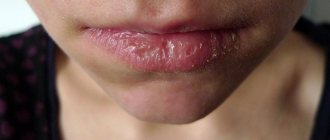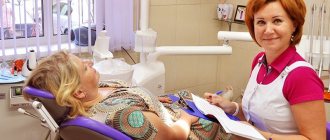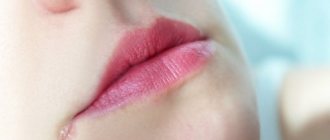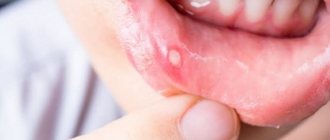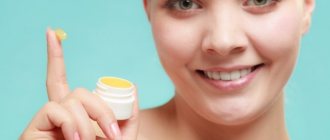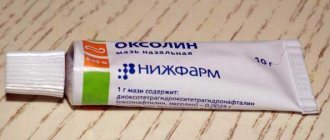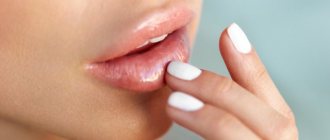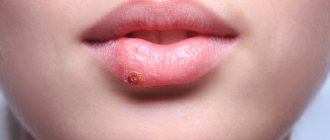Author of the article:
Soldatova Lyudmila Nikolaevna
Candidate of Medical Sciences, Professor of the Department of Clinical Dentistry of the St. Petersburg Medical and Social Institute, Chief Physician of the Alfa-Dent Dental Clinic, St. Petersburg
Seizures are a violation of the integrity of the skin in the form of small “cracks” in the corners of the mouth, caused by inflammation. This inflammation occurs when microbes that are normally present in the body of every person begin to multiply uncontrollably and actively feed on their host.
Active proliferation of bacteria occurs when the general resistance of the body decreases and if for some reason the immune system suffers. Flora, which is normally suppressed to a state almost imperceptible to humans, begins to feel more “at ease” and becomes pathogenic. Thus, the very appearance of such a nuisance as jams in the corners of the mouth may indicate systemic problems of the whole organism.
Description of the pathology
The appearance of an inflammatory process in the body, indicating injury to the mucous membrane or skin in the corners of the mouth, experts call angulitis. Among patients suffering from an unpleasant pathology, another name for the disease is common: seizures.
Angulitis is not dangerous to human health: jams cause pain when opening the mouth and aesthetic discomfort when communicating with other people.
At the initial stage, itchy microcracks appear on the lips, which, if left untreated, turn into bleeding wounds. If you ignore their appearance, the jams may not heal for a long time. Treatment at an early stage of pathology development will prevent the formation of purulent ulcers at the site of cracks.
What it is?
Zaeda is an inflammation of the skin and mucous membrane in the corners of the mouth, which occurs very often at any age, in almost everyone. In addition to the skin, the mucous membrane of the mouth can also be affected when jammed. Of course, jam is not a medical term, but a folk one, but it has become so integrated into the medical terminology of Russian-speaking doctors that the real names of this pathology can rarely be heard.
Medical names for zayeda:
- Angulite;
- Angular cheilitis (cheilitis - inflammation of the lips);
- Angular stomatitis;
- Slit-like impetigo (streptococcal infection).
And angulitis received the name “jam” because it was previously believed that the corners of the mouth became inflamed when a person ate something wrong or overate (“jaze” - because of food).
So, a jam is usually a skin defect, which is accompanied by discomfort, an annoying flaw in the mirror, and does not pose any danger to human life and health. But angulitis can also be a symptom and manifestation of other diseases, for example, stomatitis, lack of vitamins or reduced immunity. Therefore, in any case, you should pay attention to the condition of your lips.
What types of ointments are used?
To get rid of unpleasant sensations and aesthetic defects, you should smear the wounds with special products. Their selection should be taken responsibly. It is important to know the nature of angulitis.
Dermatitis is an inflammatory skin lesion on the arms or legs, accompanied by extensive rashes, swelling, itching and burning. To permanently get rid of a skin disease, complex therapy is used, consisting of medications for internal use, hormonal and non-hormonal ointments and creams. Read more in the article: “how to treat dermatitis on the hands.”
If bumps on the skin in the corners of the lips are the result of fungal growth or a viral infection, then antimicrobial agents will not help cure them. Depending on the cause of the jam, getting rid of the pathological process should occur using different types of means:
- Antifungal medications treat angulitis caused by candida fungal infection.
- Antiseptics will help get rid of irritation in the corner of the lips caused by pathogenic bacteria. For severe inflammation, topical antibiotics are used.
- Antiviral drugs are effective in treating seizures caused by a viral infection.
Sometimes the cause of redness is stress or a lack of vitamins. In this case, to get rid of the pathology, you should change your lifestyle.
Treatment for jamming in the corners of the mouth
To determine how to treat seizures, sometimes you have to consult with specialists in various fields, including an endocrinologist, an infectious disease specialist, a gastroenterologist, and a hematologist. It is better if the patient can be treated by a team of doctors in one clinic.
How to get rid of a jam forever? To do this, it is necessary to eliminate the infection and high humidity of the affected area. An antifungal ointment is usually prescribed for seizures, and in the presence of a secondary infection, antibacterial drugs are prescribed. In some cases, a dermatologist may prescribe a cream with glucocorticoids, but self-medication with such drugs is strictly not recommended. Special safe ointments and other medications are selected for children.
How to treat sticking in the corners of the lips if they are not caused by an infectious process? In this case, it is necessary to clarify their cause (vitamin deficiency, anemia, diabetes, etc.) and, if possible, eliminate it. The skin lesions themselves are treated with a neutral agent, for example, Vaseline. It is important to quit smoking and organize a proper diet rich in proteins and vitamins.
Many patients are looking for an effective home remedy for seizures. In this case, the doctor suggests the following methods:
- rubbing the skin with slices of fresh cucumber;
- treating the corners of the mouth with aloe juice;
- lubricating cracks with tea tree oil, which can be purchased at a pharmacy and mixed with honey or a few drops of liquid vitamin E;
- drinking plenty of water;
- eating leafy greens, tomatoes, carrots, fruits rich in vitamins.
The medicine for seizure must be used for a long time, until the cracks are completely healed and signs of inflammation disappear.
Review of antifungals
The process of completely getting rid of a candida fungal infection takes a lot of time. To treat cracks in the corners of the lips, the following will help:
| Drug name | Active substance | Description | How to treat |
| Nystatin ointment | nystatin | The active substances have a destructive effect on fungal cells. | Apply twice a day in a thin layer to the problem area. Treatment should be continued for 7-10 days. Sometimes the treatment period can be extended to 1 month. Contraindications include pregnancy. |
| Levorin ointment | levorin | It has a high chemotherapeutic effect against fungal spores. | Apply 2 to 4 times a day to infected areas of the skin and mucous membranes. The course of treatment is 10-14 days. |
| The drug Clotrimazole | clotrimazole | Promotes active destruction of fungal cells. Prevents complications from angulitis. | Apply to a previously cleaned and well-dried area of skin. Use 1-3 times a day. The course of treatment is 1 month. |
The listed drugs are effective in treating fungal infections. But they are not recommended for use in case of bacterial infection.
Bitterness in the mouth can be caused by both food and medicine, and serious illnesses. To clarify the cause, you should pay attention to other symptoms of possible illness. Read more in the article: “Bitterness in the mouth causes what disease.”
Medicines and treatments
Zaeda requires drug treatment in all cases except mild forms in children and adolescents. To get rid of the disease, it is enough for them to stop licking their lips in the wind. Consultation with a specialist is necessary to make a correct diagnosis. Most likely, the doctor will prescribe a comprehensive treatment consisting of:
- combating the underlying progressive disease;
- treating the jam with antiseptic non-alcohol preparations;
- use of antibacterial, antifungal or antiseptic creams and ointments (depending on the morphology of the disease);
- use of wound-healing drugs (Levomekol, Bepanten, Tea tree oil, etc.)
- replenishment of vitamins and microelements in the body;
Anti-inflammatory drugs are prescribed depending on the morphology (origin) of the disease: antifungal drugs for the treatment of angulitis, antibacterial drugs for the fight against impetigo. Drugs are most often produced in the form of ointments, creams or solutions for external use.
Antiseptics for cracks in the corners of the mouth
Treatment of the affected areas with antiseptic drugs is always carried out, regardless of the type of seizure. This will help localize the disease, prevent damage to healthy areas of the skin, and also prevent the growth of pathogenic microflora. It is important to use only non-alcoholic antiseptic medications.
Alcohol antiseptics aggravate cracks and erosions and increase the healing process. It is strictly prohibited to use them in the treatment of seizures. 96% alcohol can cause a burn not only to the affected, but also to a healthy area of the epidermis. Thus, cauterization with iodine, fucorcin and boric alcohol should be classified in this case as methods of alternative medicine and used with caution at your own peril and risk.
Experts most often recommend the following antiseptics:
- Miramistin has an antifungal and antibacterial effect. Helps prevent infection of healthy skin, stimulates the appearance of protective reactions, stops inflammatory and purulent processes in wounds. Available in the form of a solution. It is necessary to treat the affected areas for 7 days. The drug can cause allergic reactions, so it should be used with caution, especially when treating children.
- Furacilin solution is an effective antimicrobial agent that promotes the renewal of the epidermis and the healing of purulent wounds. Available in tablets. To prepare the solution, you need to crush the tablet into powder and dissolve it in 100 g of distilled water. Wash the wounds with a swab soaked in the solution.
- Chlorhexidine has a bactericidal antiseptic effect, effectively fights microorganisms, preventing their reproduction . It has a long-lasting antibacterial effect and remains active upon contact with purulent and bleeding wounds. The solution is used to irrigate wounds or as an application from a cotton swab to the affected surface for 1–3 minutes.
- Hydrogen peroxide helps remove clots of pus, blood and dead tissue from wounds. When used, skin hypersensitivity and burning are possible.
- Sulfur ointment is an excellent antiparasitic and antimicrobial agent. Used in complex therapy of dermatological diseases, including seizures. You need to apply the ointment 2-3 times a day to the affected areas.
- Metrogyl Denta is an antimicrobial drug with an antiseptic effect. Available in gel form. The drug is not used to treat children under 6 years of age.
- Vishnevsky ointment is one of the most popular means for accelerating the healing process. Improves blood circulation in areas of application, has an antiseptic and bactericidal effect. Produces an immunomodulatory local effect, which has a positive effect on the treatment of seizures. The ointment is applied externally.
Photo gallery: antiseptic agents
Metrogyl Denta is available in the form of a gel.
Sulfur ointment is an emulsion-based suspension
The antiseptic chlorhexidine destroys a number of strains of microorganisms
Now in pharmacies you can also buy an instant form of furatsilin - Avexima
Allergy sufferers should use Miramistin with caution
Hydrogen peroxide is the most affordable antiseptic
Vishnevsky ointment is a time-tested remedy
Antifungal drugs
Candidiasis most often affects people with reduced immunity. The process of complete recovery from Candida fungus is quite long and can take several months, because it is necessary not only to relieve the symptoms of the disease, but also to get rid of their causative agents. This is why it is necessary to use targeted antifungal drugs:
- The action of Nystatin ointment (Nystatin) is most effective against fungi of the Candida family . Fights directly against the main components of the fungal cell. Apply a thin layer to the infected area. Duration of treatment is from 7 to 10 days, extension possible up to 4 weeks. Contraindication for use is pregnancy.
- Levorin ointment is an effective antimycotic agent that has chemotherapeutic activity against the Candida fungus. The ointment is applied 2–4 times a day to problem areas of the mucous membrane and skin. The course of treatment with the drug is from 10 to 14 days. In case of inflammation of the mucous membrane, it is recommended to rinse your mouth with Levorin solution 3 times a day for three weeks.
- Clotrimazole in the form of an ointment prevents serious consequences and infectious complications in angulitis . Actively destroys fungal cells. Before using Clotrimazole, the infected area should be thoroughly washed and dried, only then apply a thin layer of ointment and lightly rub into the skin. Apply 1 to 3 times a day, the course of treatment can last up to 4 weeks.
Photo gallery: antifungal ointments
Nystatin ointment is an effective remedy for seizures
Levorin ointment is an antifungal antibiotic.
Clotrimazole ointment can be used for up to 4 weeks
Antibacterial agents
To eliminate jams caused by bacteria, you can use both local and broad-spectrum antibiotics. A doctor must prescribe such treatment. Most often, the following antibiotics are recommended for impetigo:
- tetracyclines (Doxycycline, Tetracycline, etc.);
- penicillins (Amoxicillin, Amoxiclav, Augmentin, etc.);
- macrolides (Clarithromycin, Erythromycin, etc.).
Antibacterial ointments successfully cope with streptococcal seizures:
- Tetracycline ointment is a local antibiotic. It has a strong antibacterial and wound-healing effect. The product can be used from the age of eight. Apply the ointment to the skin 1-2 times a day; it can also be applied with a bandage for 12-24 hours.
- Baneocin ointment combines an antimicrobial and bactericidal agent . Used for local treatment of infectious seizures, drying them out. The ointment is applied 2-3 times a day to the affected areas or used as a compress under a bandage.
- Erythromycin ointment is a broad-spectrum antibiotic. It is an irreplaceable alternative to penicillin antibiotics. Apply to skin 3 times a day.
Photo gallery: antibacterial ointments
Erythromycin is a broad-spectrum antibiotic
Baneocin ointment is effective as a compress under a plaster
Tetracycline is one of the most accessible antibiotics
What vitamins are needed
Antibacterial and antifungal agents fight the causative agents of the disease, but with a weakened immune system or lack of vitamins, the seizure can recur again and again. It is necessary to fight against unpleasant sensations, such as pain and burning, and use wound healing agents. For a speedy recovery, in addition to specialized treatment, it is necessary to use drugs aimed at:
- Maintaining immunity. Immunomodulators activate the body's defenses, accelerate the healing process, and prevent relapses of the disease (Grippferon, Viferon, Likopid, Derinat, Anaferon, etc.).
- replenishment of the following vitamins and microelements in the body:
- vitamin B2 (Natures Life, Solgar, Coenzymated-B2 preparations Riboflavin) is found in green vegetables, cereals, potatoes, eggs, yeast, etc.
- Vitamin A (Retinol acetate, Fish oil) is rich in fatty fish,
- iron (Sorbifer Durules, Maltofer, Ferrum Lek) is found in red meat, buckwheat, pumpkin seeds, etc.;
- Vitamin E (Aevit, Biovital, Alpha-tocopherol acetate solution in oil) can be obtained in the required quantities from vegetable oils, various nuts and seeds.
- vitamin PP or nicotinic acid (Nikoverin, Niacin, Apelagrin) is found in chicken meat, eggs, liver, porcini mushrooms, corn, legumes and cereals;
- Wound healing and relief of discomfort. Auxiliary agents are prescribed on days 2–3 of treatment (Bepanten, Levomekol, Tea Tree Oil, Panthenol).
Treatment of jams in the corners of the lips: medications - table
| Name of the drug | homeopathy | release form | active substance | pharmacology | indications for use | Contraindications | Age restrictions | Price |
| Advantan | No |
| methylprednisolone aceponate | Glucocorticosteroids (GCS) |
|
| from 4 months | 570 rub. |
| Akriderm | No | cream and ointment for external use | betamethasone dipropionate | Glucocorticosteroids (GCS) |
|
| Use with caution for children under 12 years of age | 125 rub. |
| Argosulfan | No | cream | silver sulfathiazole | antimicrobial agent |
|
| age up to 2 months, prematurity | 380 rub. |
| Baneocin | No | ointment, powder | bacitracin, neomycin | antibacterial drug |
|
| from 0 years | 380 rub. |
| Bepanten | No | ointment, cream, lotion | Dexpanthenol |
|
| individual intolerance to components | from 0 years | 610 rub. |
| Vitaon (Karavaev balm) | Yes | oily liquid, oil | herbal extracts:
|
|
| individual intolerance to components | from 0 years | 250 rub. |
| Hyoxysone | No | ointment | oxytetracycline hydrochloride, hydrocortisone acetate | antibacterial and anti-inflammatory drug |
|
| from 8 years old | 70 rub |
| Zovirax | No | ointment, cream, tablets in ampoules | Acyclovir | antiviral drug |
| dehydration, kidney failure | from 0 years | 550 rub. |
| Clotrimazole | No | cream, ointment, gel, solution, tablets, suppositories | clotrimazole | antifungal drug |
| individual intolerance to components | from 0 years | 70 rub |
| Levomekol | No | ointment | chloramphenicol, methyluracil, dioxomethyltetrahydropyrimidine | antimicrobial and dehydrating agent |
|
| from 3 years | 80 rub |
| Levorin | No | ointment, suppositories, tablets, solution for external use | levorin | antifungal drug | treatment of diseases caused by Candida fungus |
| from 2 years | 60 rub |
| Tea tree oil | Yes | oil, gel, cream, candles | Terpene hydrate, terpenes |
|
| not compatible with benzoyl peroxide, salicylic acid, isotretinoin, tretinoin and other skin drying agents | from 0 years | 125 rub. |
| Metrogil Denta | No | gel | metronidazole benzoate | antimicrobial drug |
| age up to 6 years | from 6 years old | 220 rub. |
| Miramistin | No | topical solution | benzyldimethyl-myristoylamino-propylammonium chloride monohydrate | external antiseptic |
| individual intolerance to components | from 3 years | 320 rub. |
| Nystatin | No | ointment, suppositories, tablets | nystatin | antifungal drug | candidiasis |
| ointment from 1 year, tablets from 18 years | 80 rub |
| Oxolinic ointment | No | ointment | oxolin | antiviral drug | viral skin diseases | individual intolerance to components | from 0 years | 60 rub |
| Sulfuric ointment | No | ointment for external use | sulfur | bactericidal, antiparasitic and fungicidal drug | scabies, seborrheic dermatitis | individual intolerance to components | from 2 months | 24 rub. |
| Sintomycin | No | ointment | chloramphenicol | broad antimicrobial action drug |
|
| from 4 weeks | 75 RUR |
| Solcoseryl | No | ointment, gel | deproteinized dialysate from the blood of healthy dairy calves | A drug that improves trophism and tissue regeneration |
| hypersensitivity to components | from 0 years | 242 rub. |
| Streptocide | No | tablets, ointment, powder, liniment | sulfonamide | antibacterial agent with bacteriostatic effect |
|
| liniment from 3 months, ointment and powder from 3 years. | 60 rub |
| Tetracycline (tetracycline ointment) | No | ointment for external use | tetracycline | bacteriostatic effect |
|
| from 8 years old | 54 RUR |
| Triderm | No | ointment, cream | Betamethasone dipropionate, clotrimazole |
|
|
| from 2 years old | 774 RUR |
| Holisal | No | gel | Choline salicylate, cetalkonium chloride | antimicrobial, analgesic and anti-inflammatory agent |
| individual intolerance to components | from 1 year | 153 RUR |
| Celestoderm cream B | No | cream for external use | betamethasone | local glucocorticoid effect |
|
| from 6 months | 251 RUR |
| Erythromycin | No | tablets, ointment | erythromycin | bacteriostatic antibiotic |
|
| from 0 years | 84 RUR |
Video: rating of pharmaceutical drugs for seizures
Traditional methods of treatment
Traditional medicine has accumulated many recipes for the treatment of cracks in the corners of the lips, many of them can cope with both fungal and infectious jams. There are recipes with dubious effects, such as applying sulfur and cauterizing with a hot object. In any case, traditional medicine should be used as part of drug treatment, and should not be abused.
The most popular remedies for seizures
- Honey, milk and walnuts. Preparation: add powdered nuts to honey. Pass through a blender and add milk. Stir the resulting mixture thoroughly and let it brew for fifteen minutes. Directions for use: moisten a cotton swab with the resulting slurry and apply a band-aid to the area overnight. Repeat until the jam disappears.
- Aloe infusion. Preparation: place several aloe leaves in the refrigerator for four hours. Take out the leaves, cut them, pour 400 ml of boiling water. Place in a dark place and let it brew for about a day. Directions for use: wipe the spots 2-3 times a day until they disappear completely.
- Kalanchoe leaves:
Houseplant Kalanchoe helps heal cracks in the corners of the mouth
Preparation and method of use: squeeze the juice from freshly picked leaves of the plant. Wipe the affected areas several times a day.
- Carrots, soda, lemon, olive oil and aloe. Preparation: boil one carrot, add 2 tablespoons of olive oil, 1 teaspoon of soda and 2 tablespoons of lemon juice. Pour boiling water over a couple of fresh aloe leaves. Grate or beat with a blender and mix. Directions for use: Apply to patches for 20 minutes 3-4 times a day.
Use of ointments D-Panthenol and Bepanten
The active ingredient of D-Panthenol is a derivative of pantothenic acid, dexapanthenol. Penetrating into the layers of the affected skin, dexapanthenol begins to act like vitamin B5.
The substance actively participates in vital metabolic processes.
Dexapanthenol also supports the natural functions of the upper layers of the epithelium, increasing the rate of skin regeneration. When the integrity of the skin is compromised due to the appearance of jams in the corners of the mouth, the need for dexapanthenol increases several times. You can replenish it by choosing D-Panthenol for treatment. How D-Panthenol works for angulitis:
- normalizes metabolism at the cellular level;
- increases the strength of collagen fibers;
- improves regenerative processes;
- is an anti-inflammatory agent.
Bepanten is considered an analogue of D-Panthenol. The active ingredient in both products is the same. After applying Bepanten, a person with an infection on the lips feels a slight cooling effect, which helps reduce pain. How often it is used: apply a thin layer of the drug to the site of infection three times a day. The course of treatment is 7-10 days.
Symptoms
The onset of the disease is very similar to herpes: small blisters form in the corners of the mouth, which themselves cause discomfort with burning and itching. However, they burst quite quickly, and in their place small but very painful cracks form, which become covered with dense crusts and interfere with eating, moving the lips, yawning and talking.
Sticking in the corners of the mouth can be caused by two reasons:
- Bacteria of the genus streptococcus. This is the most common type of seizure, it includes all the symptoms described above, but it is characterized by a high probability of complete recovery.
- Candidomycotic type of seizure. It is caused by yeast fungi of the genus Candida. The peculiarity of this type is that although it occurs much less frequently than the first ones, it is characterized by a rapid transition to a chronic form. This means that with any decrease in immunity, uncomfortable cracks in the corners of the mouth appear again.
You can find out the nature of your disease from a dermatologist. Only he, having ordered tests for research in the laboratory, can say with certainty what caused this particular problem.
We will look at candidal infections and what methods can be used to cure or alleviate their course.
Use of the drug Levomekol
In its effect on the affected skin, Levomekol is similar to D-Panthenol. Levomekol contains substances that are active against gram-positive bacteria, which cause the appearance of angulitis. Levomekol reduces inflammatory processes and fights pathogenic microflora. Its components quickly penetrate into the deep layers of the epidermis and act as stimulators of recovery processes.
The active antimicrobial effect of Levomekol persists even if purulent processes begin in the areas of infection. How to use: apply the product 2-3 times a day. Improvements occur on the second day after starting use. A specific bitter taste may remain in the mouth. After using Levomekol, you should not drink hot liquid or eat food.
No contraindications for use have been identified. People prone to allergic reactions in rare cases experience skin rashes and slight swelling. If you stop using the drug, the skin reactions will disappear immediately. Levomekol can be used to treat seizures in adults and children. You can purchase the drug at any pharmacy without a prescription.
How to treat seizures with Metrogyl Denta?
Experts recommend treating angulitis with the drug Metrogyl Denta, which is actively used in dental practice. The effectiveness of the product for seizures is confirmed by the presence of two active components in its composition: the antiseptic chlorhexidine and the antimicrobial drug metronidazole.
Chlorhexidine has increased activity against gram-positive and gram-negative bacteria. After applying the drug to the infected area, a thin film forms on the skin. It provides long-term exposure to the active substance. Metronidazole is used to treat diseases that are caused by the proliferation of harmful microorganisms. Its action is to damage the DNA chains of bacteria. Chlorhexidine helps speed up the recovery process of the skin.
How to use Metrogyl Denta: apply a thin layer of the drug to the cracks in the corner of the mouth twice a day. Used in adults over 18 years of age. It is not recommended to use the product to treat seizures in children.
How to use Teymur's paste?
An effective antiseptic, Teimurova paste gently dries the affected areas of the skin and pleasantly deodorizes them. Active substances included in the ointment:
- salicylic and boric acid;
- sodium tetraborate;
- lead acetate;
- mint oil;
- zinc oxide.
Thanks to the action of these substances, after the first application of the ointment, erosive areas dry out and cracks in the skin soften. The product helps to destroy pathogenic bacteria and relieve the inflammatory process. Medical practice shows that the use of paste is effective in the presence of fungal infection. The components of the drug reduce pain, cool the skin and dilate blood vessels to improve blood flow.
The paste is applied to the dried area of the skin in the corners of the lips in a thin layer. The drug is gently rubbed into the affected area for 2-3 minutes. Use twice a day for 1-2 weeks. Contraindications include: childhood, pregnancy and lactation.
Zinc ointment for the treatment of angulitis
You can cure seizures with zinc ointment. The active substance is zinc oxide. It has a powerful antiseptic and drying effect. After applying the product, the intensity of the release of purulent exudate decreases, and inflammatory symptoms decrease. Irritated areas of the skin are calmed, and the necessary protective layer is formed from repeated damage by harmful microorganisms.
Apply a small amount of product to the affected areas. It is applied with a cotton swab and gently rubbed until completely absorbed. Contraindications include individual intolerance to zinc oxide. If signs of skin rashes, itching and hyperemia appear, use of the ointment should be stopped immediately.
Application of Vishnevsky ointment
The active ingredients of the product are castor oil, birch tar and xeroform. The ointment relieves inflammation and acts as a good antiseptic. When a small amount of the drug gets on irritated skin, the action of the receptors is activated. This leads to improved blood supply to the affected areas.
Blood circulation stimulates the healing process of the skin and mucous membranes.
When the product is applied to a wound, it is important to be careful: Vishnevsky ointment should not come into contact with the oral mucosa.
After using it, you must wash your hands well to avoid getting the healing ingredients into your nose and eyes. If, through negligence, the product gets on the mucous membrane, you need to rinse your mouth with plenty of clean water.
Symptoms and photos
In adults, a crack in the corner of the mouth during its formation goes through several stages. Initially, bubbles or nodules form in the corner of the mouth (see photo above). Bacteria penetrate the skin and mucous membrane of the oral cavity, and are accompanied by the following symptoms:
- burning around the mouth;
- itchy sensations;
- pain when opening the mouth;
- wet discharge from mother-in-law;
- swelling of the affected area;
- an unpleasant feeling of tightness.
During this period, any movement of the lips (smiling or chewing food) can provoke rupture of the skin, resulting in the formation of cracks. Afterwards, the skin may begin to peel or become covered with a crust (plaque). With even slight movement of the lips, tears form, and this is accompanied by pain.
A crack caused by streptococcal fungal infection can lead to deep tears (even bleeding).
Difference from herpes
Seizures are divided into certain types depending on the initial cause of their appearance, which is easiest to determine at the second stage of development of the pathology - when the crusts have not yet appeared, but there is already a crack itself and discharge from it.
Visually, at the third stage of development, it is almost impossible to distinguish it from herpes. So how are these two diseases different?
- The appearance of herpes is caused by the presence of a herpes infection in the body. Jams can be the result of many infections, fungi, and even mechanical damage, which subsequently becomes infected from the outside.
- Herpes appears around the mouth on the lips, under the nose and on other parts of the body. Seizures appear exclusively in the corners of the mouth.
- Herpes looks like many small sores that develop into one large wound. The jam starts directly from the cracks.
- Herpes, if left untreated, can grow in any direction, making the person want to constantly scratch around the affected area. Seizures can spread further only as a result of constant mechanical damage to the skin, and this again occurs through cracks.
Since seizures and herpes are activated at moments of weakness of the human body, they are often combined into one affected area. It all starts with a banal seizure and continues with herpes. This happens very often. Therefore, it is better to visit a doctor and find out “what exactly” needs to be dealt with and with what drugs.
Herpes
How to treat with antibiotics?
Tetracycline ointment is known for a wide range of applications, due to the active action of its constituent components against various bacteria. The ointment is classified as a local antibiotic. The product applied to the infected area helps slow the growth of pathogenic microorganisms by disrupting protein production.
The active ingredient is the antibiotic tetracycline. It is active against staphylococci, salmonella, streptococci, chlamydia. In order to treat seizures, use 3% ointment. Unlike tablets of the same name, the drug does not have a systemic effect on the condition of the body due to its low exposure to it.
Apply the product twice a day using a cotton swab. It can be used in childhood if the patient is over 8 years old. You can quickly get rid of angulitis by using special dressings with Tetracycline ointment. They can be kept on the affected areas for several hours.
A good alternative to penicillin-based antibiotics is Erythromycin ointment. It is applied to the inflamed area three times a day. The active substance is an antibiotic from the macrolide group, erythromycin.
Prevention of angulitis in children
In childhood, to prevent streptococcal angulitis, it is often enough just to follow simple hygiene rules and make small adjustments to the diet.
Also follows:
- Ask your child not to lick his lips in the cold.
- Purchase and use chapstick to prevent peeling and dry lips, which lead to the formation of cracks and subsequent infection.
- Include more foods in your menu that contain B vitamins, especially vitamin B2 (for example, carrots).
Candidal infections in children are observed with a systematic decrease in immunity, which is often caused by poor nutrition, high emotional stress, and stress. If a child’s binge eating persists for a long time, consult a doctor, review the family’s diet, reduce the child’s load during the day (for example, cancel clubs and sections for a while, allow him to take an extra day off from school).
Antiviral drugs for angulitis
Provided that the seizures appeared as a result of damage to the body by a viral infection, they are treated with antiviral ointments. The active ingredients are acyclovir or penciclovir. Among the effective drugs are: Zovirax, Fenistil Pencivir, Vivorax, Herperax.
When applying the product, be sure to use a cotton swab. The herpes virus easily spreads to nearby areas. Apply the drug 2-3 times a day in a thick layer, without rubbing into the skin. Contraindications include pregnancy and lactation.
Causes
In adults, seizures usually appear during the cold season, when the activity of metabolic processes in the body decreases. One of the predisposing factors is the presence of chronic somatic diseases, which are characterized by seasonal exacerbations. A weakened immune system leads to increased activity of opportunistic microflora.
The immediate cause of seizures due to decreased immunity are:
- bacteria (mainly streptococci);
- yeast-like fungi of the genus Candida;
- viral infection (most often the herpes virus).
Please note: external factors leading to jamming include prolonged wetting of the corners of the mouth with saliva due to malocclusion and hypersalivation (increased salivation). In this case, maceration (impregnation with liquid and softening) of the skin occurs.
Factors contributing to the activation of microflora:
- ARVI (including influenza);
- general hypothermia;
- overheating of the body;
- prolonged exacerbations of chronic pathologies;
Zaeda can appear after direct contact with a sick person (for example, when kissing) or when using his dishes and personal hygiene products (toothbrushes, etc.).
Reasons for seizure also include:
- skin microtraumas;
- dry skin;
- low level of hygiene (especially with pathological occlusion, use of braces and carious lesions);
- hypovitaminosis, in particular – vitamin B2 deficiency in the body.
Some diseases (for example, diabetes) can prolong the healing process of lesions and complicate their course.
Seizures usually appear during the cold season, when the activity of metabolic processes in the body decreases. One of the predisposing factors is the presence of chronic somatic diseases, which are characterized by seasonal exacerbations. A weakened immune system leads to increased activity of opportunistic microflora.
The immediate cause of seizures due to decreased immunity are:
- bacteria (mainly streptococci);
- yeast-like fungi of the genus Candida;
- viral infection (most often the herpes virus).
Please note: external factors leading to jamming include prolonged wetting of the corners of the mouth with saliva due to malocclusion and hypersalivation (increased salivation). In this case, maceration (impregnation with liquid and softening) of the skin occurs.
Factors contributing to the activation of microflora:
- ARVI (including influenza);
- general hypothermia;
- overheating of the body;
- prolonged exacerbations of chronic pathologies;
Please note: seizures can appear after direct contact with a sick person (for example, when kissing) or when using their utensils and personal hygiene products (toothbrushes, etc.).
Reasons for seizure also include:
- skin microtraumas;
- dry skin;
- low level of hygiene (especially with pathological occlusion, use of braces and carious lesions);
- hypovitaminosis, in particular – vitamin B2 deficiency in the body.
Important: some diseases (for example, diabetes) can prolong the healing process of a seizure and complicate its course.
General principles of treatment with ointments
Before starting to use the drug, you need to treat the skin with an antiseptic. Ointments are used 2-3 times a day. Apply a thin layer, covering not only the wound, but also a small area around it. For effective treatment, you should avoid drinking and eating after applying the product.
For severe lesions, it is recommended to make compresses with medicinal agents.
To do this, use sterile bandages, which are applied to the affected area for half an hour. This time is enough for the effects of medicinal components. After the compress is removed, the remaining drug is left on the skin.
Treatment of angulitis is recommended to begin immediately after the first signs of pathology appear. With the help of effective medications, you can avoid the disease becoming chronic, which is not at all easy to get rid of. Using anti-jam remedies will help get rid of unpleasant symptoms within a few days.

